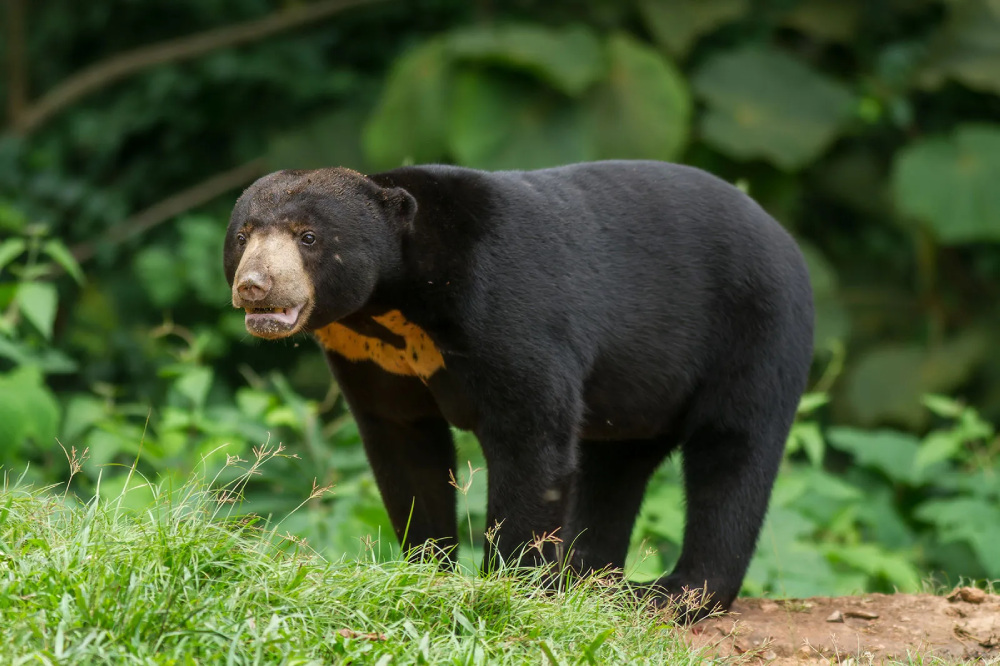The Malayan sun bear, also known as the honey bear, is one of the lesser-known yet fascinating species in the bear family. Scientifically known as *Helarctos malayanus*, this bear is native to the dense tropical forests of Southeast Asia. Despite its relatively small size compared to other bear species, the Malayan sun bear boasts unique characteristics and plays a crucial role in its ecosystem. This article delves into the biology, behavior, habitat, conservation status, and cultural significance of the Malayan sun bear.
Physical Characteristics
The Malayan sun bear is the smallest member of the bear family, Ursidae. Adult males typically weigh between 60 to 150 pounds and stand about 4 to 5 feet tall when on their hind legs. Females are generally smaller, weighing between 45 to 90 pounds. The bear’s most distinctive feature is the orange or cream-colored crescent patch on its chest, which is said to resemble the rising or setting sun, giving the species its name.
Their fur is short and sleek, adapted to the hot and humid conditions of their rainforest habitat. The sun bear’s fur is predominantly black, providing camouflage in the shadowy underbrush. They have large paws with long, curved claws that are well-suited for climbing trees and tearing open logs to access insects and honey. Their strong jaws and long tongue, which can extend up to 10 inches, are specialized for extracting honey from beehives and grubs from wood.

Habitat and Distribution
Malayan sun bears inhabit the tropical forests of Southeast Asia, including the countries of Malaysia, Thailand, Vietnam, Cambodia, Laos, Indonesia (Sumatra and Borneo), and Myanmar. They prefer lowland forests and are seldom found in mountainous regions. These bears are excellent climbers and often build nests high in the trees to rest and escape predators.
The sun bear’s range is unfortunately shrinking due to deforestation and habitat fragmentation. Large swathes of their native habitat are being cleared for agricultural purposes, particularly for palm oil plantations. This loss of habitat poses a significant threat to their survival, limiting their range and reducing the availability of food sources.
Diet and Feeding Habits
The Malayan sun bear is omnivorous, with a diet that varies widely depending on the availability of food. They primarily feed on fruits, berries, roots, and insects. However, their diet also includes small vertebrates, birds, eggs, and particularly honey, earning them the nickname “honey bear.” Their long claws and strong limbs allow them to break open termite mounds and beehives efficiently.
Fruits make up a substantial part of their diet, and they play a crucial role in seed dispersal within their ecosystem. By consuming a wide variety of fruits and then excreting the seeds in different locations, sun bears contribute to the health and regeneration of the forest.
Behavior and Social Structure
Malayan sun bears are primarily solitary animals, with individuals typically coming together only during mating season. They are diurnal, active during the day, although they can become nocturnal in areas with high human disturbance. Despite their small size, sun bears are known for their aggressive behavior when threatened. They have powerful jaws and claws that can inflict serious injuries on potential predators, including humans.
They communicate through vocalizations, body postures, and scent markings. Vocalizations include a range of sounds from grunts and snorts to roars and barks, used to express emotions such as fear, aggression, and contentment. Scent marking, using their strong-smelling urine and feces, helps establish territory and communicate with other bears.
Reproduction and Lifespan
Sun bears have no specific breeding season, although births may peak at certain times of the year. Females typically give birth to one or two cubs after a gestation period of about 95 to 100 days. Cubs are born blind and helpless, weighing around 300 grams. They remain dependent on their mother for about two years, learning vital survival skills such as climbing, foraging, and self-defense.
In the wild, Malayan sun bears have an average lifespan of about 20 years, although they can live longer in captivity, with some individuals reaching up to 30 years.
Conservation Status and Threats
The International Union for Conservation of Nature (IUCN) lists the Malayan sun bear as Vulnerable, with populations declining due to habitat loss, poaching, and illegal wildlife trade. Deforestation for timber and agriculture, particularly palm oil plantations, has led to significant habitat loss. Furthermore, sun bears are hunted for their body parts, which are used in traditional medicine and sold as exotic pets.
Conservation efforts are underway to protect the sun bear and its habitat. Several organizations, including the Bornean Sun Bear Conservation Centre (BSBCC) in Malaysia, focus on rescuing and rehabilitating captive bears, conducting research, and raising public awareness about the species’ plight. Legal protection under national and international laws, including CITES (the Convention on International Trade in Endangered Species of Wild Fauna and Flora), aims to curb illegal trade and ensure sustainable conservation practices.
Cultural Significance
In some cultures within its range, the sun bear holds symbolic significance. In Malaysian folklore, the sun bear is often associated with the forest and regarded as a guardian of the jungle. Its distinctive chest patch has led to various myths and stories about its origin and meaning. However, the bear’s elusive nature means it remains less prominent in folklore compared to other, more conspicuous wildlife.
Conclusion
The Malayan sun bear is a remarkable species with unique adaptations that allow it to thrive in the dense tropical forests of Southeast Asia. Despite its critical role in maintaining the health of its ecosystem, it faces numerous threats from human activities. Conservation efforts are essential to protect this elusive bear and ensure its survival for future generations. Through increased awareness, habitat preservation, and stringent anti-poaching measures, we can help secure a future for the Malayan sun bear in the wild.









